Criminal Law: Murder and Manslaughter
Added on 2022-11-17
22 Pages4927 Words392 Views
Running Head: CRIMINAL LAW
CRIMINAL LAW
Name of the Student
Name of the University
Author’s Note
CRIMINAL LAW
Name of the Student
Name of the University
Author’s Note
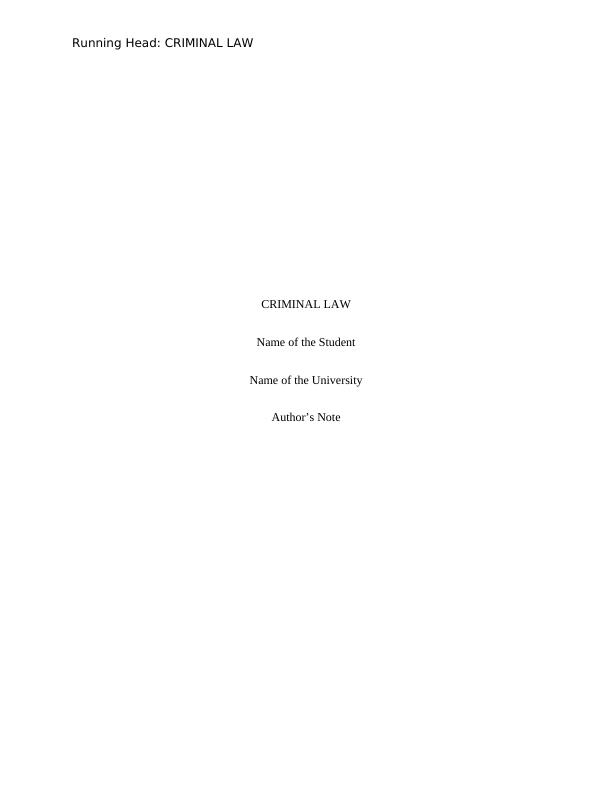
CRIMINAL LAW1
Question 1:
Issue:
The issue in the case is whether Carole is liable for the death of Louise.
Rules:
Homicide Act 1957 is the governing law for the provisions of murder,
attempt to murder and manslaughter as a criminal offence. In addition, the
Coroner and Justice Act is the governing act for the matters of homicide
including manslaughter and murder. Homicide is constituted of two offences
namely the murder and the manslaughter.
The elements for murder are that the alleged convict should be of
mentally sane state of mind, unlawfully kills (meaning without any self-
defense or any other justified cause of killing), and another living human
being and with the intention to kill that person. The person should be a
reasonable creature, living and breathing through his or her lungs. This has
been stated and confirmed in Rance v Mid-Downs Health Authority1. The
intention for murder holds the most important element to constitute the
crime. The person should have primary motive to kill or cause bodily harm to
the other person and the same shall be inferred by the jury through the
foreseeable harm. The principle was explained in R vs. Woollin2. The
necessary intention is drawn from the knowledge that the defendant feels
1 (1991) 1 All ER 801
2 [1999] 1 Cr App R 8 (HOL)
Question 1:
Issue:
The issue in the case is whether Carole is liable for the death of Louise.
Rules:
Homicide Act 1957 is the governing law for the provisions of murder,
attempt to murder and manslaughter as a criminal offence. In addition, the
Coroner and Justice Act is the governing act for the matters of homicide
including manslaughter and murder. Homicide is constituted of two offences
namely the murder and the manslaughter.
The elements for murder are that the alleged convict should be of
mentally sane state of mind, unlawfully kills (meaning without any self-
defense or any other justified cause of killing), and another living human
being and with the intention to kill that person. The person should be a
reasonable creature, living and breathing through his or her lungs. This has
been stated and confirmed in Rance v Mid-Downs Health Authority1. The
intention for murder holds the most important element to constitute the
crime. The person should have primary motive to kill or cause bodily harm to
the other person and the same shall be inferred by the jury through the
foreseeable harm. The principle was explained in R vs. Woollin2. The
necessary intention is drawn from the knowledge that the defendant feels
1 (1991) 1 All ER 801
2 [1999] 1 Cr App R 8 (HOL)
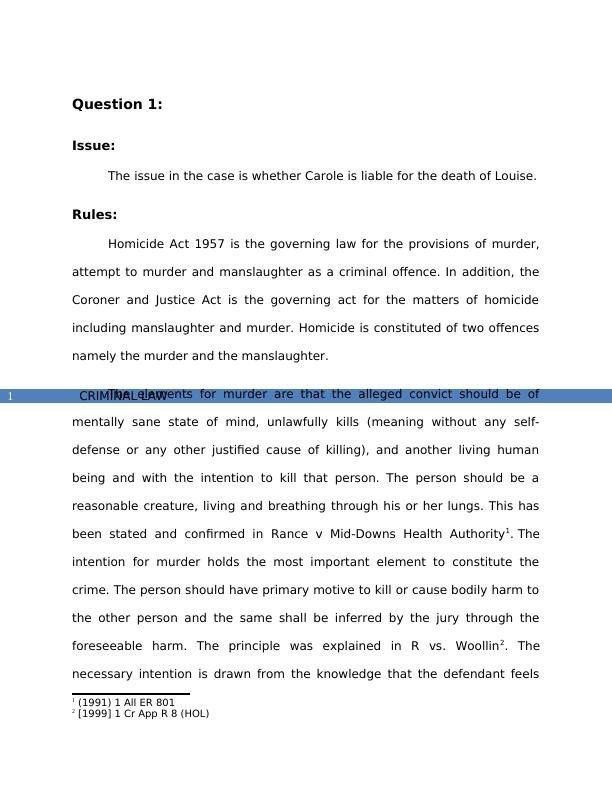
CRIMINAL LAW2
sure that death or grievous bodily harm is what the defendant would
appreciate against the other person. However, the intention to kill is further
explained in R vs. Grimwood3, as murder requires the intention kill and not
just causes grievous bodily harm. Further, the causation is what makes a
man guilty other than the intention. The death of the person should have
arisen from the cause of actions taken or omitted by the defendant. In other
words, the actions taken or omitted by the defendant should result in t6he
death of the other person. This has further been explained in R vs. Dyson4.
In R vs. Reid,5 it has been held that the report of defendant’s medical
condition should be obtained from local Crown Court and the same should be
intimidated to the prosecution. In head injuries, the Crown’s pathologist
performs post-partum investigation including the neurological analysis for
which the production of report may take up to 12 days’ time. Further, in R vs.
Cokesix Lubemba6, it was held that the prosecution should take into
consideration the probability of mentally disorder offenders. Therefore, the
prosecution should consider the Psychological Evidence Kit.
Section 6 of the Criminal Law Act 1967 states that the prosecution for
murder may result in an alternative verdict called the manslaughter, which is
an indictment to murder where a person may not be found guilty, but that
person may be found guilty for manslaughter. Manslaughter offers partial
defenses to the alleged offender, as firstly voluntary killing, which is the loss
3 (1962) 3 All ER 285
4 (1908) 1 Cr App R 13.
5 (2002)1Cr App R21
6 [2014] EWCA Crim 2064 [2014] para 38.
sure that death or grievous bodily harm is what the defendant would
appreciate against the other person. However, the intention to kill is further
explained in R vs. Grimwood3, as murder requires the intention kill and not
just causes grievous bodily harm. Further, the causation is what makes a
man guilty other than the intention. The death of the person should have
arisen from the cause of actions taken or omitted by the defendant. In other
words, the actions taken or omitted by the defendant should result in t6he
death of the other person. This has further been explained in R vs. Dyson4.
In R vs. Reid,5 it has been held that the report of defendant’s medical
condition should be obtained from local Crown Court and the same should be
intimidated to the prosecution. In head injuries, the Crown’s pathologist
performs post-partum investigation including the neurological analysis for
which the production of report may take up to 12 days’ time. Further, in R vs.
Cokesix Lubemba6, it was held that the prosecution should take into
consideration the probability of mentally disorder offenders. Therefore, the
prosecution should consider the Psychological Evidence Kit.
Section 6 of the Criminal Law Act 1967 states that the prosecution for
murder may result in an alternative verdict called the manslaughter, which is
an indictment to murder where a person may not be found guilty, but that
person may be found guilty for manslaughter. Manslaughter offers partial
defenses to the alleged offender, as firstly voluntary killing, which is the loss
3 (1962) 3 All ER 285
4 (1908) 1 Cr App R 13.
5 (2002)1Cr App R21
6 [2014] EWCA Crim 2064 [2014] para 38.
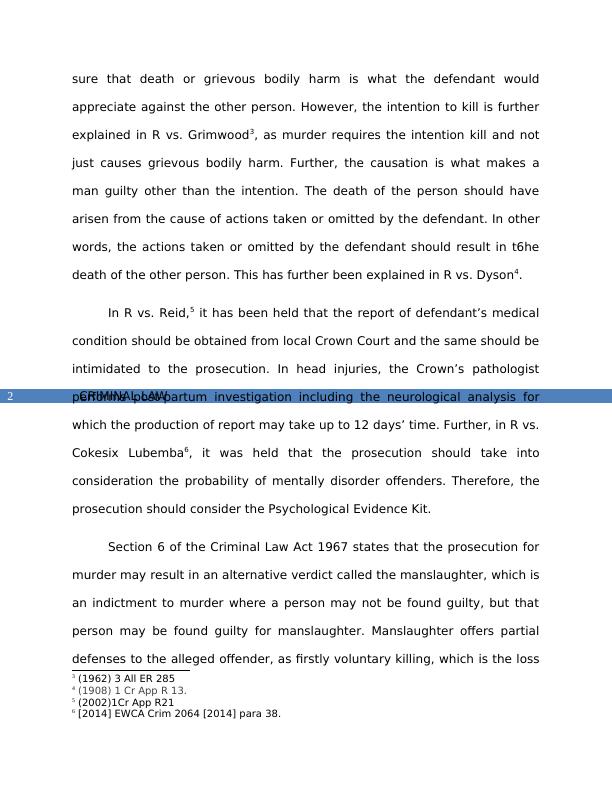
CRIMINAL LAW3
of control and other, is the involuntary killing involving diminished
responsibility and pursuant to the pact of suicide. The first element explains
the loss of control wherein Section 54(1)(a)(b) and (c) of Coroners and Justice
Act 2009, states the following three components to constitute the defense:
Loss of control means the actual control lost by the party, which
led to the act committed or omitted.
Triggering point means, the gravity of the act committed or
words spoken that led to the commission or omission of an act.
In R vs. Clinton and Others,7 it was held by the court that the
prosecution should take into consideration the gravity of the
circumstances and the degree to which the plaintiff leading to
the justifiable conclusion made by the defendant that he has
been seriously wronged and that he should now react wronged
the defendant.
Objective test to ensure age, sex, tolerance potentiality by any
other reasonable man. In other words, it means that the
potentiality of the defendant should be tested to ensure the
tolerance capacity of any reasonable man in the given situation
so that the quantum of reaction may be assessed by the court.
7 [2012] EWCA Crim 2, at para.11
of control and other, is the involuntary killing involving diminished
responsibility and pursuant to the pact of suicide. The first element explains
the loss of control wherein Section 54(1)(a)(b) and (c) of Coroners and Justice
Act 2009, states the following three components to constitute the defense:
Loss of control means the actual control lost by the party, which
led to the act committed or omitted.
Triggering point means, the gravity of the act committed or
words spoken that led to the commission or omission of an act.
In R vs. Clinton and Others,7 it was held by the court that the
prosecution should take into consideration the gravity of the
circumstances and the degree to which the plaintiff leading to
the justifiable conclusion made by the defendant that he has
been seriously wronged and that he should now react wronged
the defendant.
Objective test to ensure age, sex, tolerance potentiality by any
other reasonable man. In other words, it means that the
potentiality of the defendant should be tested to ensure the
tolerance capacity of any reasonable man in the given situation
so that the quantum of reaction may be assessed by the court.
7 [2012] EWCA Crim 2, at para.11

CRIMINAL LAW4
In R vs. Christian8, it was held that the quantum of reaction should be
in the probable range of the triggering point. The damage should be
quantum to the trigger to lose control.
Section 52 of the Coroners and Justice Act 2009 states the elements
constituting diminished responsibility:
Abnormal functioning of brain- this means that the mental
condition of the brain should be abnormal or disabled to think
about the natural consequences of the actions of the person.
Such abnormality should have arisen from a diagnosed mental
condition- this means that such mental condition that led to the
commission or the omission of the act should be diagnosed in a
medical clinic by an expert of medical science so that the expert
assistance may be given to the defendant in normal course of life
prior to the happening of events.
Such condition has led to the person’s disability to exercise self-
control or understand the nature of his conduct or both- this
means that the disability has led the person or to lose
consciousness about his or her ability to exercise the self-control
or understand the consequences of his or her actions.
Such disability provides an explanation for his conduct- this
means the conduct resulting in the death or harm is the outcome
of such disability of the person.
8 [2018] EWCA Crim 1344
In R vs. Christian8, it was held that the quantum of reaction should be
in the probable range of the triggering point. The damage should be
quantum to the trigger to lose control.
Section 52 of the Coroners and Justice Act 2009 states the elements
constituting diminished responsibility:
Abnormal functioning of brain- this means that the mental
condition of the brain should be abnormal or disabled to think
about the natural consequences of the actions of the person.
Such abnormality should have arisen from a diagnosed mental
condition- this means that such mental condition that led to the
commission or the omission of the act should be diagnosed in a
medical clinic by an expert of medical science so that the expert
assistance may be given to the defendant in normal course of life
prior to the happening of events.
Such condition has led to the person’s disability to exercise self-
control or understand the nature of his conduct or both- this
means that the disability has led the person or to lose
consciousness about his or her ability to exercise the self-control
or understand the consequences of his or her actions.
Such disability provides an explanation for his conduct- this
means the conduct resulting in the death or harm is the outcome
of such disability of the person.
8 [2018] EWCA Crim 1344
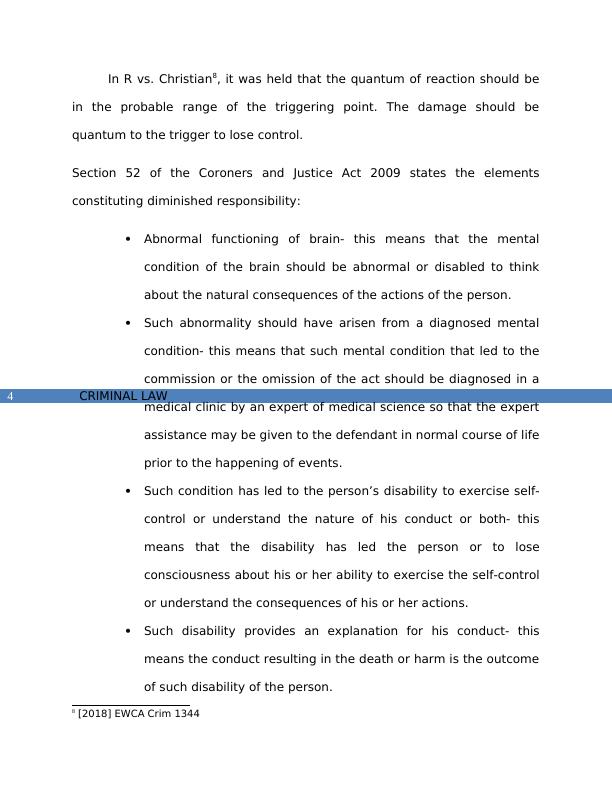
CRIMINAL LAW5
In R vs. Byrne9, the Court as the disability in the process of thinking
explains the abnormal functioning of the brain or reasoning as any
reasonable man would do under the same facts and circumstances.
However, in R vs. Conroy10 the decision was based on the rule that the
person’s disability to should be diagnosed as a medical condition and not as
the spur of moment. Further, in R vs. Brennan11 it was confirmed by the
Court that an expert psychiatrist should be permitted to provide his or her
opinion on all the elements including the ultimate deciding issue of the case.
In R vs. Joyce Kay12, the partial defense was upheld by the court on the
ground the the diagnosed condition of schizrophinia was so severe that in
spite of voluntary intoxication, the condition would have prevailed even in
the absence of intoxication.
In unlawful manslaughter, negligence holds one of the most important
elements wherein, in case the parties are sound, the court assumes the
consent being exercised at free will. Mere supply of dangerous products does
not make the party liable for the unlawful killing. This was confirmed in R vs.
Kennedy (Simon)13.
Section 5 of the Domestic Violence, Crime and Victims Act 2004,
amended in 2012 extends its applicability to a vulnerable adult or child has
died or suffered grave injurious due to violence by family people.
9 [1960] 2 Q.B. 396
10 [2017] EWCA Crim 81
11 [2014] EWCA Crim 2387.
12 [2017] EWCA Crim 647
13 (2007) 3 W.L.R. 612
In R vs. Byrne9, the Court as the disability in the process of thinking
explains the abnormal functioning of the brain or reasoning as any
reasonable man would do under the same facts and circumstances.
However, in R vs. Conroy10 the decision was based on the rule that the
person’s disability to should be diagnosed as a medical condition and not as
the spur of moment. Further, in R vs. Brennan11 it was confirmed by the
Court that an expert psychiatrist should be permitted to provide his or her
opinion on all the elements including the ultimate deciding issue of the case.
In R vs. Joyce Kay12, the partial defense was upheld by the court on the
ground the the diagnosed condition of schizrophinia was so severe that in
spite of voluntary intoxication, the condition would have prevailed even in
the absence of intoxication.
In unlawful manslaughter, negligence holds one of the most important
elements wherein, in case the parties are sound, the court assumes the
consent being exercised at free will. Mere supply of dangerous products does
not make the party liable for the unlawful killing. This was confirmed in R vs.
Kennedy (Simon)13.
Section 5 of the Domestic Violence, Crime and Victims Act 2004,
amended in 2012 extends its applicability to a vulnerable adult or child has
died or suffered grave injurious due to violence by family people.
9 [1960] 2 Q.B. 396
10 [2017] EWCA Crim 81
11 [2014] EWCA Crim 2387.
12 [2017] EWCA Crim 647
13 (2007) 3 W.L.R. 612
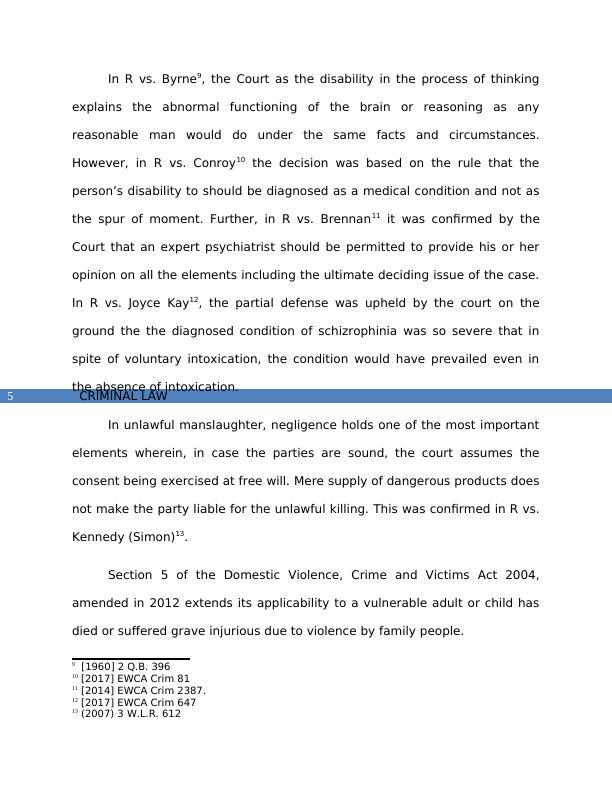
End of preview
Want to access all the pages? Upload your documents or become a member.
Related Documents
Criminal Law Research on Murder Case and Territorial Jurisdictionlg...
|10
|3551
|74
Introduction to Criminology and Criminal Justicelg...
|4
|726
|255
Criminal Law: Murder and Defenceslg...
|12
|3002
|428
Section 300 of Criminal Code Act, 1899 | Criminal Lawlg...
|16
|2874
|25
Negligent Homicide: Understanding the NSW Law and Violationlg...
|9
|2410
|386
Criminal Law Assignment 2022lg...
|9
|1728
|25
